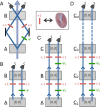Path identity as a source of high-dimensional entanglement
- PMID: 33004628
- PMCID: PMC7584901
- DOI: 10.1073/pnas.2011405117
Path identity as a source of high-dimensional entanglement
Abstract
We present an experimental demonstration of a general entanglement-generation framework, where the form of the entangled state is independent of the physical process used to produce the particles. It is the indistinguishability of multiple generation processes and the geometry of the setup that give rise to the entanglement. Such a framework, termed entanglement by path identity, exhibits a high degree of customizability. We employ one class of such geometries to build a modular source of photon pairs that are high-dimensionally entangled in their orbital angular momentum. We demonstrate the creation of three-dimensionally entangled states and show how to incrementally increase the dimensionality of entanglement. The generated states retain their quality even in higher dimensions. In addition, the design of our source allows for its generalization to various degrees of freedom and even for the implementation in integrated compact devices. The concept of entanglement by path identity itself is a general scheme and allows for construction of sources producing also customized states of multiple photons. We therefore expect that future quantum technologies and fundamental tests of nature in higher dimensions will benefit from this approach.
Keywords: entanglement by path identity; high-dimensional entanglement; orbital angular momentum; path indistinguishability.
Copyright © 2020 the Author(s). Published by PNAS.
Figures



References
-
- Wang C., Deng F. G., Li Y. S., Liu X. S., Long G. L., Quantum secure direct communication with high-dimension quantum superdense coding. Phys. Rev. A 71, 044305 (2005).
-
- Barreiro J. T., Wei T. C., Kwiat P. G., Beating the channel capacity limit for linear photonic superdense coding. Nat. Phys. 4, 282–286 (2008).
-
- Huber M., Pawłowski M., Weak randomness in device-independent quantum key distribution and the advantage of using high-dimensional entanglement. Phys. Rev. 88, 032309 (2013).
-
- Cerf N. J., Bourennane M., Karlsson A., Gisin N., Security of quantum key distribution using -level systems. Phys. Rev. Lett. 88, 127902 (2002). - PubMed
LinkOut - more resources
Full Text Sources

